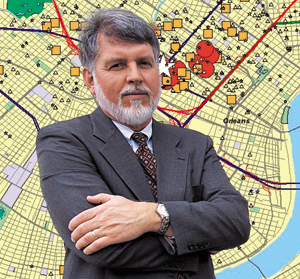Location, location, location

Not long ago, investigators at the Louisiana Social Services Department would spend hundreds of hours poring over documents to uncover evidence of food-stamp fraud.
Not long ago, investigators at the Louisiana Social Services Department would spend hundreds of hours poring over documents to uncover evidence of food-stamp fraud.The department was buried under mountains of data from its electronic benefits system, which recorded transactions by individual recipients and retailers. State investigators had to review thousands of pages of printouts in their search for suspicious activity. But with a new Web-based system that can access transactional data and display it in a geographical context, department officials now can have that same information in their hands in about 30 minutes and review food stamp activity in a designated region or neighborhood."This system allows me to go in and target a specific area and, in just a few minutes, pull together most of the information I need to identify a suspicious pattern of activity," said Raymond Pease, assistant director of the Fraud and Recovery Section of the Louisiana Department of Social Services.The ability to look at material in a geographic context gives investigators a fresh way to view data and reveals patterns and anomalies that might not be apparent in tabular data, Pease said. "You see new relationships that you didn't see before," he said. The Louisiana project embodies one of several trends in how government agencies are using geospatial technologies. Increasingly, state and local governments are integrating geographic information systems with other applications, such as data mining, supply-chain management and customer relationship management, to improve services.Government agencies also are combining geospatial technology with other so-called location-determination technologies, such as global positioning systems, radio frequency identification devices, network sensors and cellular networks. At the same time, the creation of geospatially enabled server platforms is facilitating the sharing of such data throughout the government enterprise. The net result will be increasing business opportunities for geospatial technology vendors and for integrators, said David Sonnen, IDC's senior consultant for spatial information management."The integrators are going to be the driver to move this spatially enabled technology into the enterprise space. Clearly, the integrators have a major role there," he said. "It is not a trivial problem to bring these enterprise solutions platforms together with spatial technology with all of these location-specific data streams." PERFECT UNIONIn Louisiana, the anti-fraud project marries business intelligence software from Information Builders Inc. of New York with GIS technology from Environmental Systems Research Institute Inc. of Redlands, Calif. Because the agency has been using the system for less than a year, it doesn't have hard numbers yet to tout its success, Pease said. But the department has identified individuals with questionable transactions and is working with law enforcement agencies to prosecute those activities, he said. "There is a geographic element to every problem you have to analyze," said Michael Corcoran, Information Builders' vice president of strategy. To help government customers use GIS, the company has integrated its WebFocus business intelligence software, which Louisiana is using, and its iWay adapter software with ESRI's products, he said. "We've tightened the mapping interface between the mapping product and our product," he said.Geospatial technologies analyze and display data representing things such as roads, rivers, property lines and building footprints. GIS is a type of geospatial technology and consists of an information system or application that stores, manages or analyzes data that represents geospatial features and supports geocentric workflows. GIS can help emergency personnel track the location of their vehicles on a map in real time during an incident, and let law enforcement personnel see where the greatest number of crimes are being committed in their jurisdictions, so they can adjust their patrols. Worldwide spending on GIS software in 2004 was $1.8 billion, of which $544 million was spent by U.S. federal, state and local government agencies, according to market research firm IDC of Framingham, Mass. ESRI has roughly 80 percent of the software market share in the federal, state and local government space, Sonnen said.State, local and provincial governments account for 65 percent of government spending worldwide, and federal governments spend the rest, according to market research firm Daratech Inc. of Cambridge, Mass. Monica Schnitger, Daratech's senior vice president of market analysis, said GIS software sales to governmental organizations are growing about 10 percent annually. Steady U.S. government sales can be attributed partially to the incorporation of GIS into homeland security solutions, she said. Accompanying the growing software sales is a strong demand for GIS-related systems integration in the public sector, she said. This is true "especially in governments where databases abound with information that is not tied together," she said. MORE MATCHESSonnen said growth during the next five years will center on tying together GIS with other applications or other location-determination technologies as well as incorporating it into IT infrastructure. This new activity in the market gives integrators a prime role in helping agencies take advantage of GIS technologies. IBM Corp., for example, is deploying its Websphere architecture as a key subcontractor to ESRI on the Interior Department's Geospatial One Stop-2 project, awarded in February. In addition to its work on GOS-2, IBM is a key subcontractor to Michael Baker Corp. of Moon Township, Pa., for the Federal Emergency Management Agency's five-year, $750 million Multi-Hazard Flood Map Modernization project, awarded last year. The company is providing support in the form of IT services, business process re-engineering, transformation, e-learning and call centers. IBM wants to assist other federal agencies to deploy geospatial technology across the enterprise, said David Beddoe, senior GIS product manager. "We're working with ESRI to move from departmental GIS implementation to enterprise GIS implementations," he said.Big Blue also does GIS-related work at the state and local level, Beddoe said. For example, the company is assisting San Francisco in applying geospatial technology for economic development as well as emergency management initiatives, he said. Another integrator, Science Applications International Corp., is helping the Michigan State Police integrate crisis management software that has a strong GIS component. The software maker is E Team Inc., a Los Angeles company that also has strategic relationships with IBM, CACI International Inc., ESRI, Microsoft Corp., Oracle Corp., Unisys Corp. and other IT companies. SAIC also is looking to combine GIS with other location technologies and build new partnerships to strengthen its offerings, said James Morentz, vice president for homeland security technology. He said SAIC has forged an alliance with Keyhole Corp., a subsidiary of Google Inc., Mountain View, Calif. Through its alliance with Keyhole, the company will be able to offer customers a database of mapping information and images collected from satellites and airplanes, he said.SAIC also is providing handheld, geospatial information that lets users visualize hidden elements of an incident scene to receive real-time operating procedures and to provide management with instant status updates of a job, he said. Plangraphics Inc. of Frankfort, Ky., has a solution known as spatial templates for emergency preparedness that lets workers extract GIS data from disparate databases and share it via a portal. The company has projects in New Jersey, New York, Ohio, Oregon and Rhode Island, as well as New York City, where its solution was refined based on experience gleaned from the Sept. 11, 2001, terrorist attacks, the company said.Plangraphics has formal and informal partnerships with Accenture Ltd., Alion Science and Technology Corp., CGI-AMS, Gray Hawk Systems Inc. and Oracle. Information Builders' iWay adaptive framework can extract information from upwards of 85 structured databases, Corcoran said. The company's expertise in fusing GIS with business intelligence applications has caught the eye of systems integrators such as Unisys. The two companies are discussing a partnership or alliance that would let Unisys leverage iWay on projects similar to its integrated criminal justice project for Volusia County, Fla., said Gerry Wethington, Unisys' vice president for public safety, justice and homeland security. The key for systems integrators that are exploring geospatial technology partnerships and alliances is to see whether the companies' technologies are compatible through common and open interfaces, Wethington said. "The thing you have to look for is a real match in terms of whether their technology and your technology are easily aligned," he said. Senior Writer William Welsh can be reached at wwelsh@postnewsweektech.comXXXSPLITXXX-San Francisco Bay Area Rapid Transit police are finding their way around the city easier these days, thanks to digital maps from MapInfo Inc.Officers riding the rails are using handheld devices, and officers in patrol cars are equipped with mobile computers. Both use a geographic information system application developed by MapInfo of Troy, N.Y. The application gives the officers direct access to the same GIS data that dispatchers have. This helps officers navigate their way through unfamiliar terrain in and around the transit system, said Carissa Goldner, CAD/RMS administrator for the Bay Area Rapid Transit District Police Department."With MapInfo's GIS technology, BART is able to route officers back from an unfamiliar jurisdiction after an off-site assist," she said, referring to one of many benefits of the technology.The project is an example of how local governments are combining GIS with other technologies. In this case, the agency has combined GIS with a wireless network.MapInfo provided the geospatial software and Galilee Enterprise Inc. of San Leandro, Calif., provided the integration services, Goldner said. Galilee digitized BART's records and tagged those records to geographic locations. It then geographically coded the rail stations, linked them to records and integrated them into a document management system, she said.The GIS application is integrated with BART's computer-aided dispatch as well as its document management systems, she said."Not only do they have the mapping technology, but they can get access to all of the other information that helps them respond to situations and coordinate with other agencies more effectively," said Sabby Nayar, MapInfo's strategic industry manager for government.The project is unique both because of its size as well as its complexity, he said. BART "is a very complex and atypical geography," he said. "It crosses five or six different counties and is a linear network of hundreds of miles of rails.""They not only have to respond to things that are on their property, but also have to coordinate with other law enforcement agencies. So from that standpoint, it is unique," Nayar said. XXXSPLITXXX-Government employees using the Geospatial One-Stop Portal likely will see a vast improvement when the next-generation site goes live in May. The project's contractors are focusing on improvements in performance, interoperability, user interface and functionality, said Pat Cummens, senior adviser for government projects with Environmental Systems Research Institute Inc. of Redlands, Calif. ESRI is the prime contractor for Geospatial One-Stop Operational Portal 2, or GOS-2, a project awarded in February by the Interior Department. The five-year contract to upgrade the prototype portal is estimated to be worth $2.3 million. ESRI's teammates are IBM Corp. and Google Inc., Mountain View, Calif. IBM is providing its Websphere portal, Google is providing a spatially enabled search appliance, and ESRI is providing essential mapping tools.The GOS-2 portal will serve as an online tool that combines thousands of geospatial resources from federal, state, local, tribal and private organizations. Its origins can be traced to the e-government initiatives launched by the Office of Management and Budget during President Bush's first term.The portal "is the nation's answer to realizing the national spatial data infrastructure in an operational system," said David Beddoe, senior GIS product manager for IBM. The Interior Department and the contractors learned from the prototype that the portal was used not only by GIS professionals, but also by various government decision-makers, Cummens said. Because some government officials who are now using the portal may not be familiar with GIS software, the contracting team is trying to make the GOS-2 portal intuitive, she said. The contractors also are refining and adding new communities of interest that let officials in different agencies or levels of government share maps and reports, she said. "We try to leverage what everyone has done, but make it easy for everyone to find it all," she said. XXXSPLITXXX-It wasn't long ago that geospatial technology was regarded as something more appropriate for the day-to-day business of public works and natural resources agencies than it was for public safety and health and human services agencies. But today a variety of government agencies are finding that geospatial technology is a versatile tool that can map just about any kind of data, said Russ Johnson, public safety solutions manager at Environmental Systems Research Institute Inc.As result, geographic information system technology has been embraced for everything from economic development and crime prevention to emergency response and disease management. "Five years ago, we were talking to people at the first-responder level who did not understand and were intimidated by the technology. Today, we have a good slice of the responders' community using it," Johnson said. "We no longer have to sell people on its value." James Morentz, vice president for homeland security with Science Applications International Corp., agreed. "There are so many business improvements that come around GIS that it is almost impossible to define someone as out of that marketplace," he said. The uptick in GIS use can be seen in the hiring of additional GIS staff and the integral role they play not only in central IT departments but also throughout agencies, according to government and industry officials. Many local governments have between 15 and 20 GIS professionals working in their IT departments, and a few others throughout the agencies, according to local government officials. The professionals help staff emergency operations centers in the event of a natural disaster occurs or is expected, they said. But only about one-third of the agencies using GIS are using it effectively, SAIC's Morentz said.That one third has "effective GIS programs that are readily incorporating information as it changes every day," he said. "They are spending a lot of money on it and getting extremely good results from it."XXXSPLITXXX-Ivan DeLoatch believes every piece of information has a geographic component. Whether it's data about troops or financial audits or food processing, geographic information cuts across every agency line of business.To that end, DeLoatch, staff director for the Federal Geographic Data Committee, leads an effort to develop a Geographic Information Systems profile for the Federal Enterprise Architecture.Much like the security and privacy profile created last year by the Office of Management and Budget's FEA Program Management Office and the CIO Council, the GIS profile will show where agencies are investing in geodata. That information will make it easier to create and share the data, DeLoatch said."You can take the geodata and overlay it on topography or hydrography or many other types of data, and it will help agencies address the challenges we have," he said. "The biggest benefit will be the ability to improve our knowledge of our lines of business."Richard Burk, OMB's chief architect, said at a recent conference on enterprise architecture that he realized the benefits of the standardizing geodata when he worked at the Housing and Urban Development Department. Using a GIS profile for HUD's enterprise architecture, a program manager saw that putting a public housing site near a waste management site was a problem.The Federal Geographic Data Committee, an intergovernmental, is working with the CIO Council and at least five agencies -- the departments of Agriculture and Interior, the Environmental Protection Agency, NASA and the National Oceanic and Atmospheric Administration -- to develop the profile. State and local government groups such as the National Association of State CIOs also are taking part.DeLoatch said the goal is to create a national GIS profile, not just a federal one. DeLoatch and Karen Siderelis, associate director for geospatial information at the Geological Survey, presented their ideas to the CIO Council late last year and are now partnering with the council's Architecture and Infrastructure Committee."GIS is a common thread through everything we are doing, much like security and privacy," said Kim Nelson, chairwoman of the council committee and the EPA's CIO. "We will use the Geospatial One-Stop architecture, which is a service-oriented architecture."DeLoatch said the GIS profile has a running start thanks to the work of the Geospatial One-Stop team. It already has done work on a search-and-discover component for finding geodata as well as drafted some basic profile philosophies."The principles are grounded in geospatial interoperability," he said. "The principles will get everyone to adhere to standard syntaxes, semantics, information discovery, information exchange interfaces and standard interfaces."DeLoatch said the GIS profile committee, which met last week for the first time, will create a profile that adheres to the set of principles and diagram an architecture that runs from collecting data to processing and disseminating it.DeLoatch said he hopes the committee can complete this high-level profile within 12 months with help from contractors already working on such efforts in agencies.Jason Miller is a senior writer with Government Computer News. He can be reached miller@postnewsweektech.com.




"This system allows me to go in and target a specific area and, in just a few minutes, pull together most of the information I need to identify a suspicious pattern of activity." ? Raymond Pease, Louisiana Department of Social Services
Photo, Stewart O. Shields; montage, Virginia Bledsoe

David Beddoe, senior GIS product manager for IBM
Rick Steele

Richard Burk, OMB's chief architect.
Rick Steele
NEXT STORY: No rocket science here